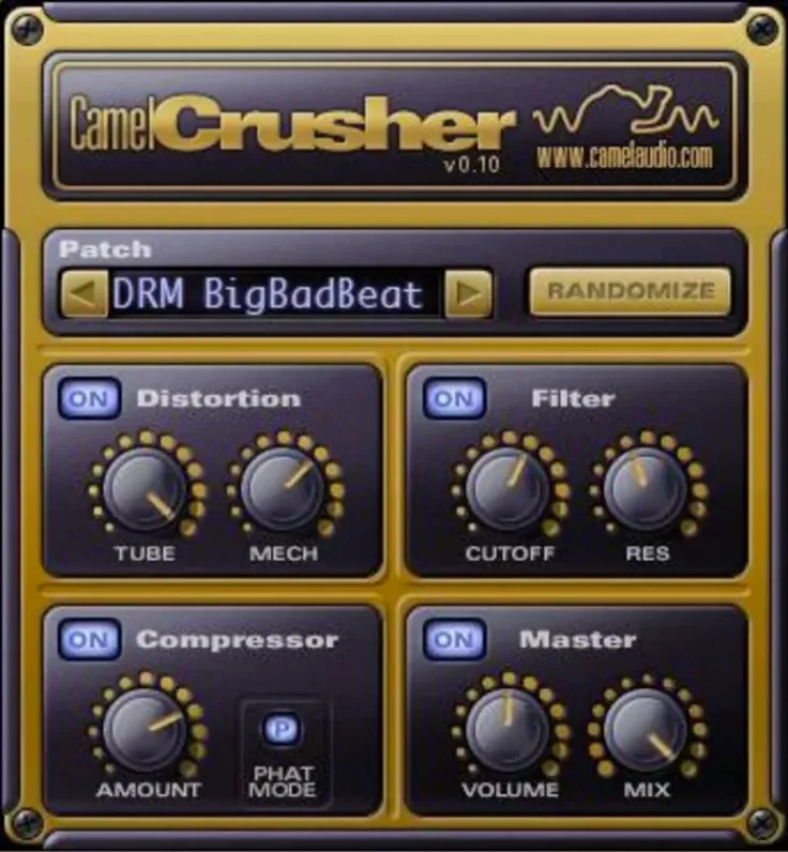Camel Crusher VST by Camel Audio Review

Camel Crusher VST is an old skool VST that became famous for its simple design and cutting-edge sounds. It is primarily a distortion and saturation plugin with onboard controls for a filter and compression.
It was acquired by Apple in 2015 and features from it were added into a stock plugin on Logic Pro X DAW called ‘Phat FX’. Before this, Camel Audio offered a more advanced and paid plugin called CamelPhat. Camel Crusher was the free version that became a staple in music production.
Camel Crusher is, at heart, a coloring multi-effect VST plugin.
- Intuitive, user-friendly interface
- Light on the CPU
- Useable presets
- Versatile use
- Not much of a learning curve
- There is currently no official source to get the plugin files
- Product discontinued, no updates or support
Producers and mixing engineers, regardless of skill level, are always hungry for alternatives to stock plugins.
Contents
Every once in a while, something like Camel Crusher VST pops up on the market.
It is a basic saturation/distortion plugin with good control, great patches, and four modules that can be set or randomized. It’s easy on the eyes and CPU, to the point, and very fun to mess around with. And, how much does it cost? Zilch!
In this post, we’ll review the VST and reveal why it went on to become one of the ‘top favorite free plugins ever!” for new and veteran music producers.
Camel Crusher Features:
The plugin UI displays 5 important sections. Up top, you have the patch selection and a randomize button. Below that you have a distortion, compressor, filter, and master module. We’ll look at each feature in more detail.
It can be subdivided into the following:
- Mechanical and Tube Distortion
- Filter or LPF with resonance and cutoff
- Compression w/ Phat Mode
- Master Module for output levels
Patch + Randomize:
The patch section allows you to access the presets. There is a good variety of pre-made sounds that are functional and adaptable. If you can’t find something to suit your taste, and you don’t want to dial it in yourself, you can experiment with the ‘Randomize’ button.
The Randomize button will only change the modules you have selected. For example, if you have master, compressor, and filter on, it will not randomize distortion. This gives you more control to find a basic patch, which you can tweak further till you are satisfied.
Compressor
Compressor is the third module, although it isn’t a full-blown compressor. You only have the option to dial in the amount or activate a preset mode via the Phat Mode button.
The compression is subtle but has good tone color. It will come in handy in scenarios where you don’t want to amplify the sound too much.
The Phat Mode, on the other hand, is a big, in-your-face boost that amplifies the compression once you’ve set the amount with the dial.
It is essentially the same sound as setting the compressor dial at maximum capacity. It certainly ‘phattens’ the tones and the toggle switch is a helpful way to A/B the two sounds.
Filter
The filter section on the UI has two knobs to set “RES” and “CUTOFF”. It is a simple high cut or low pass filter that can be used to eliminate harshness from the high frequencies caused by the distortion.
Use the cutoff knob to pinpoint the unwanted frequencies and set the resonance dial to boost once the cutoff point is fixed. It is simple but effective.
Master
The master section is to control the output levels. It has two knobs to control “VOLUME” and “MIX”. Although that is pretty self-explanatory, the Volume controls the plugin’s overall volume. The mix is similar to a dry/wet knob.
It determines how much of the plugin sound blends into the original source. At 100% is it fully wet, and at 0% there will be no influence of the plugin on the source affected sound.
How does Camel Crusher VST sound?
Although I don’t use it anymore, Camel Crusher has served me well as a versatile distortion and saturation plugin. It is versatile and sounds good if you want to add grit to 808 kicks. It also thickens guitars and synths to make them sound more chewy.
I have used it on rock and metal vocal tracks and VST drum sounds on occasion. You can think of it as a simpler version of FabFilter’s Saturn. If you can think of a frequency to fatten, Camel Crusher will find a way to make it sound better.
Overall, the VST is suited for any sound that needs to cut through the mix or enhanced. The difference can be as subtle or obvious as required, but Camel Crusher has the potential to make the resulting tone sound better than the input sound.
The best part about ice-breaking VSTs like Camel Crush is that you can derive a lot of fun by experimenting with them. One way or another, it will lead you to something you like. And, the fact that it is free, makes it a harmless ordeal to experiment with it for a few hours.
Performance
It’s fair to say that Camel Crusher is as light on the CPU as it can get. It requires a very basic skill level but it can yield interesting results. Between the presets (patches) and randomize feature, you can find something regardless of skill level.
You don’t need an in-depth understanding of each effect module, although it would be ideal to have that. If you are just starting out, tweaking the knobs will get you started. If you know what you are doing, you can get professional sounds from it.
You only need to find a creative and acceptable way to use it in your mixes.
Price and Value
It’s hard to be critical of any good plugin that is 100% free. Camel Crusher, on the other hand, would still reflect great value if it were a paid plugin. For that reason alone, it’s a must-have VST in your plugin collection.
There is one downside to it. After Apple bought it, it was dropped from the official Camel Audio website. It has become increasingly difficult to find it in its original form since 2019. However, it is currently available at this link for free.
Camel Crusher Alternatives:
- iZotope Trash 2
- Fabfilter Saturn
- Soundtoys Decapitator
Summary
Camel Audio’s Camel Crusher VST is a free saturation/distortion plugin that puts up a great performance without costing you a dime.
Considering that there are some great presets to explore and there is almost no learning curve, you can start using it to great effect right away.
Remember, there is no definitive plugin that can magically elevate your music. Good tones and mixing rely on your ear and the tasteful balance you can achieve.
Nevertheless, Camel Crusher is a good way to fatten up and add character to flavorless sounds.





